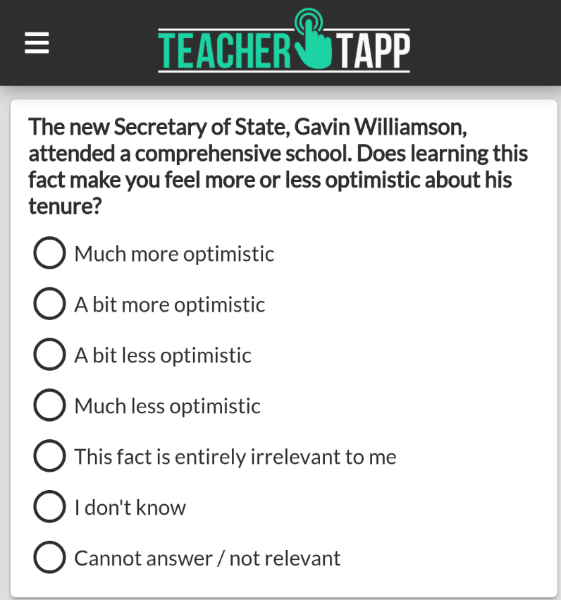Here at Teacher Tapp we have a very particular way of asking questions. We ask just three multiple choice/response questions. Every. Single. Day!
Each of our questions has up to 10 response categories.
Some days the responses are dichotomous (e.g. Yes/No) and teachers can only give one answer (known as single response or multiple ‘choice’). Often teachers might want to select more than one response that applies to them and so we allow these too (multiple response).
We frequently use Likert or rating scales where teachers can opt for how much they agree with a statement. These sorts of scales are perfect for measuring teacher’s attitudes or behaviours.
And … that’s it.
We don’t ask teachers to rank responses, or type in answers, or do grid box response questions (where there is a cross-table of buttons asking for your opinion on each sentence).
Why? Because we love these close-ended questions and they are more flexible than you might think. We can almost always find more useful information through these questions (and with our background analysis).
Plus, there are some serious advantages to the Teacher Tapp approach for questions…
1. Quicker for teachers to tapp
Teachers literally tapp the app to respond to our questions. We never ask them to type, swipe or sort responses. This makes it super-quick for teachers to answer, which is why they are happy to come back to the app every day. (Which helps us gather more and richer data).
Whilst longer surveys that involve writing responses might be fine for a paper or a desktop computer survey, nobody likes to type at length on a phone.
We also avoid any question formats that are annoying on a phone, such as grid responses. Screens that can fit into your pocket don’t tend to display big tables particularly well.
2. It increases predictability (which increases retention)
Teachers, like all humans, like a nice mixture of predictability and surprise – and that’s what Teacher Tapp delivers. The predictable part is that the questions will take seconds, rather than minutes, to answer. The surprise part is that we link to an article afterwards that they might LOVE to read and there are badges and occassional prizes/messages on the final page.
There’s also the surprise of seeing the answers! We share the results each day on the app so teachers can learn what other people in the profession think about the same topics. Teachers are often surprised to find people think so differently to themselves!
3. No respondent fatigue
Have you ever answered a survey where you start tapping or typing ANYTHING just to get to the finish line? We have too. Respondent fatigue in surveys can seriously compromise the validity of the responses – something we make certain to avoid. The responses our teachers give to questions are easy for us to code and interpret too.
4. Having just 10 response spaces forces refinement of research questions
We run big surveys that are answered by thousands of teachers. When asking a question to this many teachers, you should have a good idea of the kind of responses you are likely to get. Furthermore, we can hone the list by asking smaller groups of teachers for advice to ensure the responses are likely to reflect a true range of what’s happening on the ground. Offering just 10 responses might therefore feel like a constraint, but we find it forces us to refine exactly what it is we want to know in a useful way and only putting answers in which are genuinely relevant.
5. Open-ended questions are hard to analyse
How did that lesson go? Describe your perfect INSET day. What do you like and dislike about the last class you taught?
Open-ended questions are wonderful for finding out what people think. They are particularly wonderful when the respondent can talk through their answers, rather than have to type them. Here’s the thing about typing… it isn’t so enjoyable to do on a phone, especially when predictive text keeps making you sound illiterate! Grr…
Plus, the problems for the respondent are NOTHING compared to how difficult life gets for the person having to analyse the results. It isn’t easy to get good automated analysis of ad-hoc open-ended questions so somebody has to sift through and collate the responses somehow. This is fine if 10 people are answering the question. It’s OK if 100 people are answering the question. It is soul-destroying if 4,000 people are answering the question!
Hence, for these reasons, we stick ruthlessly to only asking multiple response questions where teachers can either select one or several answers from a list of 10 options.
Asking a question on Teacher Tapp? Try following these top tips:
- Have one objective for each question – the aim of a survey isn’t to get some responses. The aim is to answer a well-crafted research question. Take one research objective and translate it into a survey question – beware trying to answer many objectives within one question because it tends to make it hard for teachers to answer. Don’t ask ‘double-barrelled’ questions that actually ask two questions at once. For example, “How well did students behave and learn in the last lesson you taught” is double-barrelled because behaving well and learning a lot are two separate things!
- Keep your language simple and specific – our teachers find it much easier to answer questions that are short, but do define any key terms within the question and don’t assume that teachers use the same acronyms that you do!
- Avoid leading questions – “Do you agree that careers education is an essential part of the school curriculum?” is a leading question. You could ask “To what extent do you think that…” or “How high a priority should…”. Even better, try asking teachers what other parts of the curriculum should have lower or higher priority (e.g. financial literacy education, political education, and so on).
- Avoid ambiguities – Don’t take it for granted that teachers know what you mean in a question. Failing to write clear and specific questions can hinder the ability of teachers to answer consistently. If someone can interpret your question differently to the way you intended, the question needs to be improved. (We can help with this by running more questions if needed).
- Ask questions that people can answer – this might sound obvious, but there are three key reasons why teachers struggle to answer questions we ask. First, they do not know the answer – for example, classroom teachers without responsibilities do not necessarily know a great deal about processes within their school. Second, they did know the answer but have forgotten or would have to go and look something up to answer it. Our app is designed for teachers to click straightaway so looking up timetables or budgets isn’t going to work. Third, they know something did happen but find it hard to remember how long ago it was. It is fine to ask teachers whether something has happened this term or this academic year, but teachers are less likely to reliably recall whether something has happened in the last 3 years.
- Try to combine factual or objective questions with attitudinal or subjective ones – both factual and attitudinal questions are important, but they can tell you very different thing where the topic is contentious. For example, there are many things we wish were true but that in reality do not happen. Because of that, a subjective question like this would have lots of teachers agreeing with it: “Talking to students about their personal hopes and aspirations is an important part of my job.” However, we might learn something more interesting by asking the objective question: “Did you have a conversation with any student about their personal hopes or aspirations today?”. One great thing about factual questions is that they tend to reduce something called desirability bias – the tendency for people to answer questions in socially acceptable ways.
Ultimately, we are always working on our question techniques here at Teacher Tapp and we are always interested to test and learn more about the way the wording, interpretations, question order and question type affects the way answers work. We will continue sharing more here as we learn more too!
If you would like to ask a question on Teacher Tapp, get in touch with us here or via the Contact Form at the top and bottom of the page.






